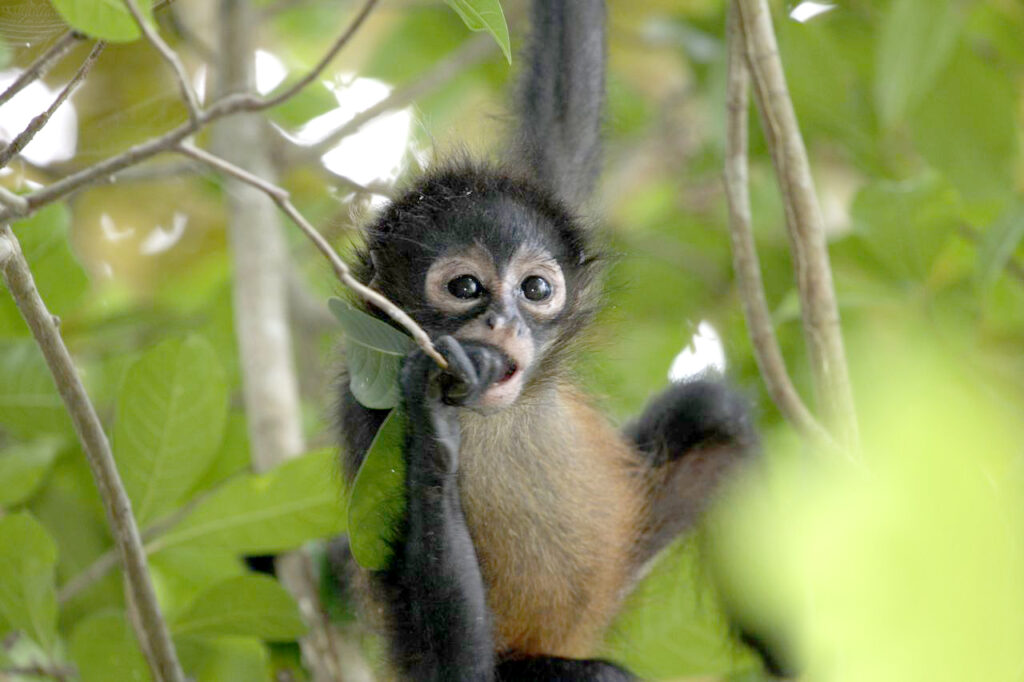Central America has a diverse array of dazzling landscapes and biospheres. Its lush rainforests and montane forests are home to a charismatic primate that has become an icon of Central American wildlife, the black-handed spider monkey.
The black-handed spider monkey is one of the seven species of spider monkeys found in Central and South America. These curious and charismatic primates can be seen swinging through the treetops, congregating noisily, and performing the extremely important function of seed dispersal throughout the forest.
All spider monkeys, including the black-handed spider monkey, play a vital role in the forest’s ecosystem. Unfortunately, every one of the seven spider monkey species is currently endangered according to the International Union for Conservation of Nature (IUCN) Red List. This article will help you better understand these fascinating but threatened creatures by sharing black-handed spider monkey facts that you may not have known.
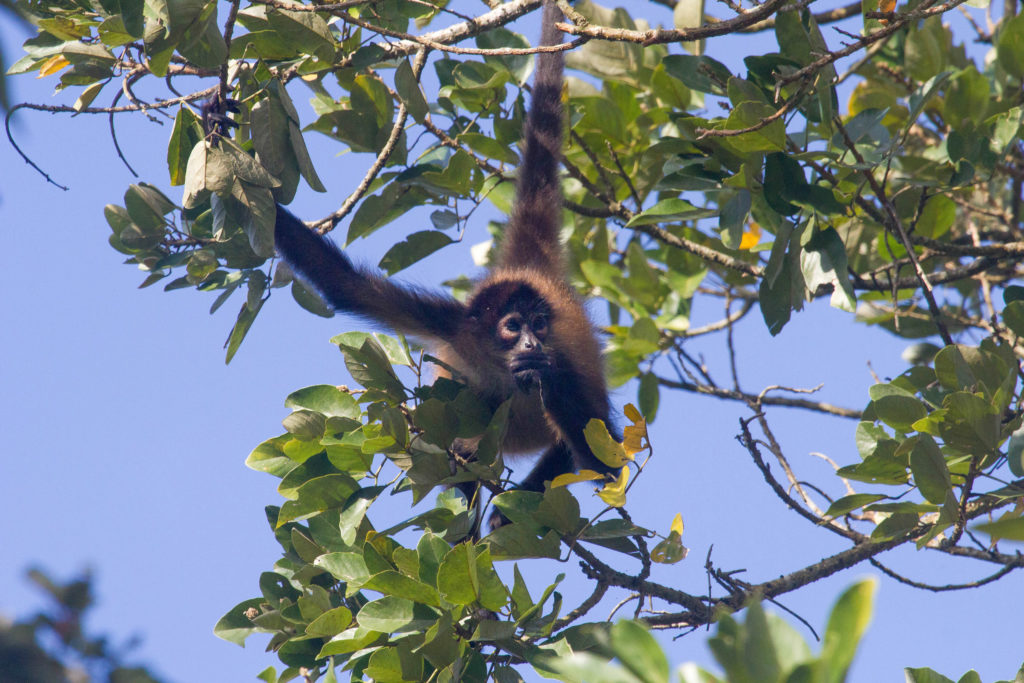
Meet the Black-Handed Spider Monkey
As New World primates, black-handed spider monkeys are distant evolutionary cousins to humans. Like us, they are smart and social, using a combination of their unique physical traits, intelligence, and group behavior to thrive in the forested habitats of Central America. Let’s learn a little more about what makes black-handed spider monkeys so special.
Appearance
Black-handed spider monkeys have expressive faces marked by light pigmentation around the eyes, nose, and muzzle. They get their name from their coloration, with lighter-colored fur on their bodies and dark, black fur covering their limbs. Babies are born with dark fur covering their entire bodies, and their adult coloration starts to show as they reach five months of age.
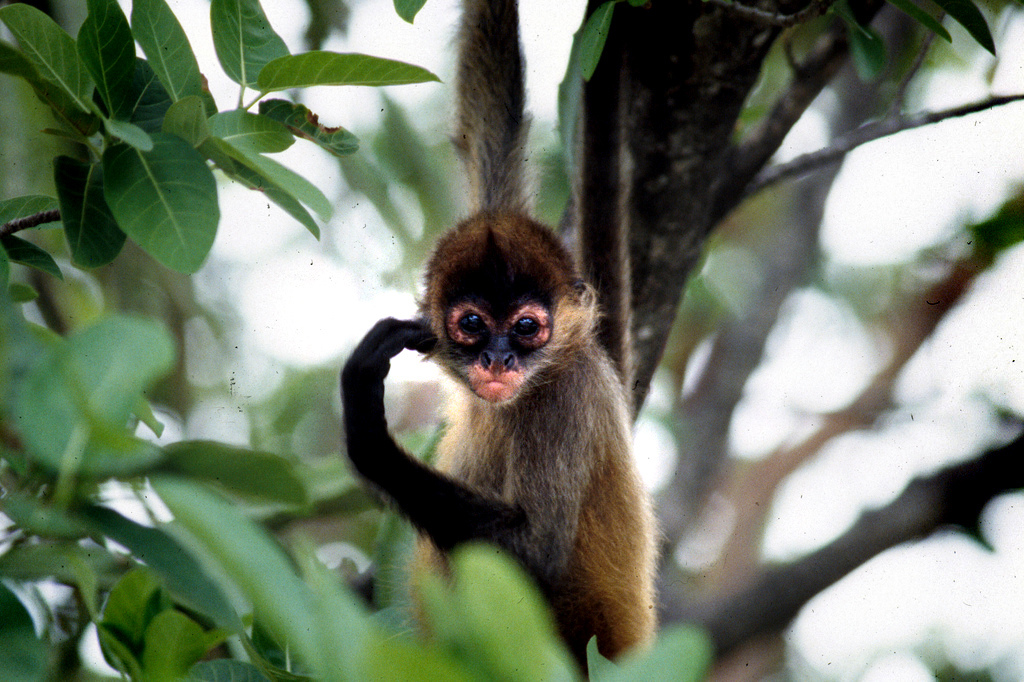
Their long tails, which grow even longer than their bodies, are prehensile with a fleshy pad under the tail’s tip. This tail is used as a fifth limb, allowing black-handed spider monkeys to grip branches as they navigate their arboreal environment.
Among the seven spider monkey species, black-handed spider monkeys are the largest. Fully mature individuals are between 12 to 25 inches long and weigh between 13 to 20 pounds. The males are slightly larger than females, but black-handed spider monkeys do not display as much sexual dimorphism as other primate species like baboons and gorillas.
Behavior
Black-handed spider monkeys are playful and social primates that form tight bonds within their troops. They have a fission-fusion social structure, where a large troop is made up of several smaller groups that roam the territory independently and congregate at full force in intervals. The subgroups within a troop usually consist of closely related individuals, most often a mother and her adolescent offsprings.
These monkeys are polygamous, with males and females taking multiple partners in short-lived mating unions known as consortships. There is no fixed mating season for black-handed spider monkeys. Instead, females take partners when they are ready to mate according to their estrous cycle. Most pregnancies result in a single birth, and females are ready to mate at intervals of two to four years.
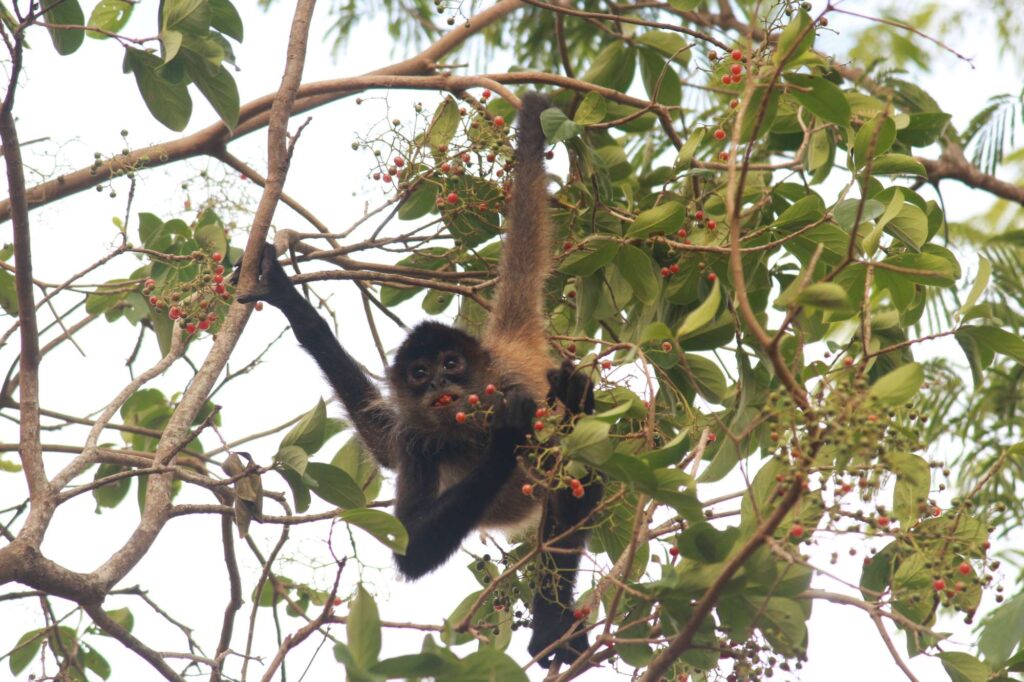
Diet
Like most monkeys, black-handed spider monkeys are primarily herbivores. They prefer a fructivorous diet, seeking out ripe, fleshy fruits as their preferred meal. This preference makes them prolific seed dispersers in the forest ecosystem, spreading fruit seeds across their habitat through their droppings.
While black-handed spider monkeys subsist on a fruit-based diet, they will occasionally supplement it with flowers, nuts, insects, arachnids, and small reptiles. So, even though they are generally considered herbivores, it’s also fair to say that black-handed spider monkeys are opportunistic omnivores.
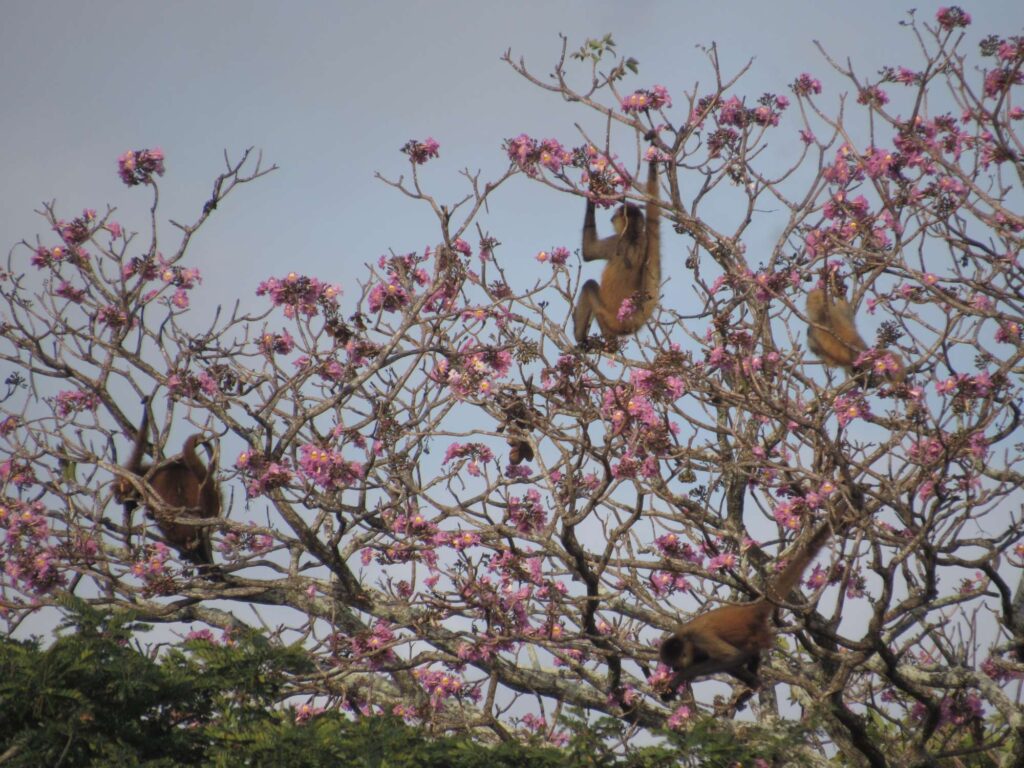
Threats Facing Black-Handed Spider Monkeys
When it comes to life in the trees, it’s literally a jungle out there for black-handed spider monkeys. Being the largest spider monkey species isn’t much protection against Central America’s apex predators which consist of jaguars, large snakes, and harpy eagles. The jungle’s insects also carry diseases that afflict spider monkeys, such as malaria. These natural threats mean that a wild black-handed spider monkey’s life expectancy is usually between 20 and 30 years. However, in captivity, these mammals have been known to reach 45 years of age.
Black-handed spider monkeys are well-adapted to cope with these natural threats. However, they are still on the endangered list because of human activity more than any other factor. The many ways humans put black-handed spider monkeys at risk include:
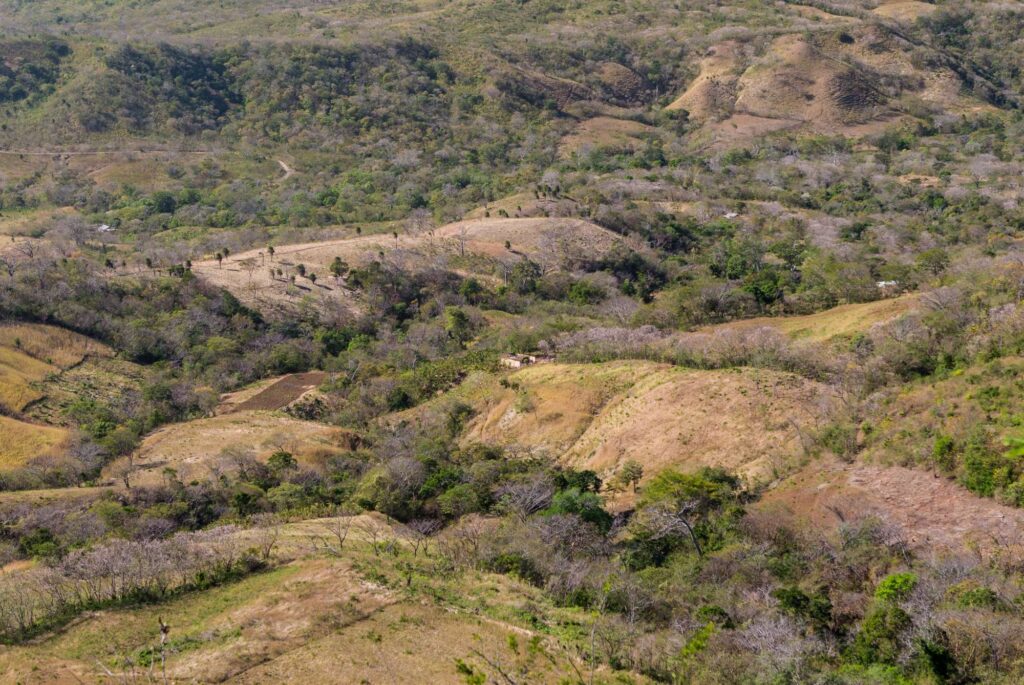
Habitat Loss
Logging in Central America has led to a significantly smaller forest cover, magnifying the threat to black-handed spider monkeys’ habitats. As treetop specialists, they rely on forests for food and places to sleep.
Illegal Wildlife Trade
The size and gregarious nature of black-handed spider monkeys make some people think they would make the perfect exotic pets. However, these monkeys don’t do well when taken out of their natural environments, and the illegal trafficking of these animals as pets is among the biggest threats to their population.
Poaching
In some Central American cultures, spider monkeys are considered fair game for hunting. The way they gather in large groups and their loud, distinctive vocalizations make them easy to track even in dense forests. Unfortunately, this means their populations are at constant risk of over-hunting.
These threats are omnipresent across their range and contribute to their endangered status. According to the IUCN Red List, there is no information on how many of these monkeys are left in the wild. However, it is helpful to know how small the populations of other spider monkey species are. The Azuero spider monkey has no more than 116 individuals while the black-browed spider monkey has at most 160 members. Meanwhile, there are around 648 Yucatan spider monkeys.

Where To See Black-Handed Spider Monkeys in Central America
Black-handed spider monkeys have a range covering the entirety of the isthmus connecting North and South America. Forests in Panama, Costa Rica, Nicaragua, Guatemala, Honduras, El Salvador, and Belize can contain black-handed spider monkeys. However, these monkeys are usually scarce and very shy, and they have been wiped out of some areas entirely. If you are in Central America and want to see a wild spider monkey, ask a local if there are any nearby.
The black-handed spider monkey’s close relative, the black-headed spider monkey, can be found in the northwestern forests of Colombia. Some primatologists claim that black-handed and black-headed spider monkeys belong to the same species, with only superficial differences in appearance and size.
Interacting With Black-Handed Spider Monkeys
If you encounter a black-handed spider monkey in the wild, consider yourself very lucky! But remember, despite their sweet appearance, these monkeys are still wild animals. They are naturally wary of humans and will indulge in displays of aggression when approached. These include breaking tree branches, making loud barks, and baring their fangs. While not life-threatening, a bite from a spider monkey can be quite painful! It’s best to appreciate these charming primates from a distance.
Lesser Known Black-Handed Spider Monkey Facts
Among Central America’s wild denizens, black-handed spider monkeys are one of the most charismatic. Here are some more interesting facts that make black-handed spider monkeys such fascinating primates:
- Unlike most primates, black-handed spider monkeys live in matriarchal societies.
- The fleshy pad on their tails bears a unique pattern. It is like an individual monkey’s fingerprint.
- The famous Mexican artist, Frida Kahlo, kept black-handed spider monkeys as pets, even including them in one of her most famous self-portraits.
- Sexually mature females sport an enlarged clitoris, which could be mistaken as a penis by an untrained observer.
- Black-handed spider monkeys lack opposable thumbs, evolving elongated, hook-like fingers while reducing the size of their thumbs to better swing through the trees.
All these traits make black-handed spider monkeys one of the most unique species in Central America.
How You Can Help Protect Black-Handed Spider Monkeys
Conservation organizations like Paso Pacifico are hard at work to guarantee a bright future for black-handed spider monkeys. Since 2005, Paso Pacifico has worked to create safe habitats for these monkeys. If you’d like to help protect these beautiful creatures, consider donating to our wildlife conservation fund.
